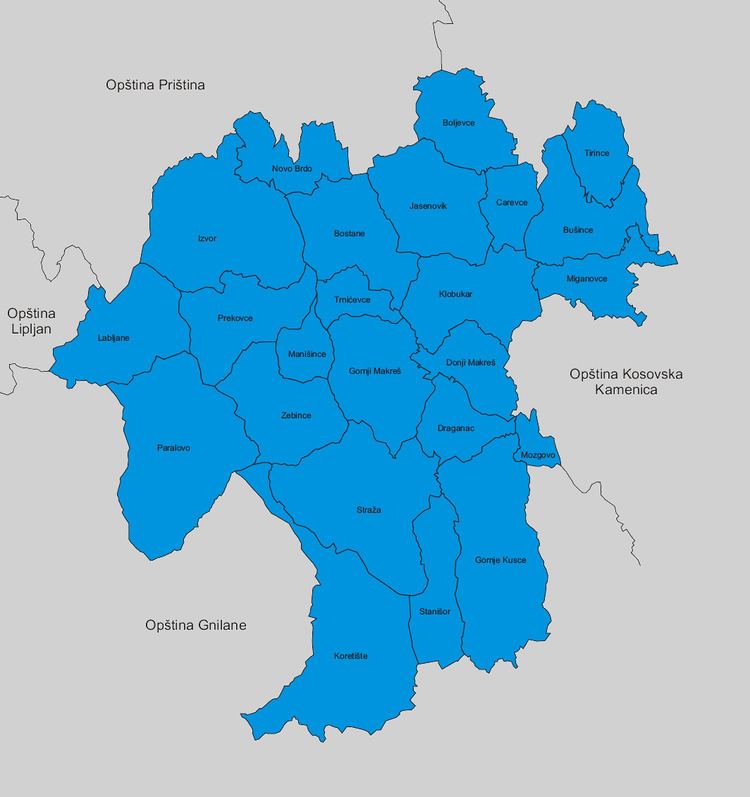Elevation 946 m (3,104 ft) Area code(s) +381 38 Area 204.2 km² Population 6,953 (2014) | Time zone CET (UTC+1) Car plates 01 Postal code 16000 | |
 | ||
Weather 19°C, Wind W at 8 km/h, 27% Humidity | ||
Novo Brdo or Novobërda or Artana (Albanian: Novobërda or Artana, Serbian Cyrillic: Ново Брдо) is a town and municipality in the Pristina district of eastern Kosovo. The population of the municipality is estimated at 6,953 people (2014).
Contents
- Map of NovobC3ABrdC3AB
- Sasa i tamara svadba izvor novo brdo kosovo
- Name
- History
- Population
- Notable people
- References
Map of Novob%C3%ABrd%C3%AB
Sasa i tamara svadba izvor novo brdo kosovo
Name
The name was derived from the medieval Serbian Novo Brdo, a mining town settled by Saxons (Sasi).
History
Novo Brdo was mentioned with its present name in historical documents as early as 1326. Previously it was known as, Novus Mons or Novamonte in Latin and as Nyeuberghe in Saxon texts. The famous Mediaeval Serbian writer Vladislav the Grammarian was born there between 1410 and 1415 [1].
Novo Brdo was a metropolis at the time, with a huge medieval Novo Brdo Fortress built on the top of an extinct volcano cone, the remains of which can be visited today, and residential sections sprawling all around. In the outer wall of the fortress a large cross is visible, built into the stones. The castle, or fortress, was thought at one point to have dated back to the time of the Serbian Empire. The population at its height was estimated to exceed 6,720 people. At the first half of 15th century, Serbian Orthodox bishops of Lipljan resided in Novo Brdo. There were mines and smelting furnaces for iron, lead, gold and silver ores. Novo Brdo silver is known by its argentum glame (an alloy of silver with 1/6-1/3 gold). In 1450 the mines of Novo Brdo were producing about 6,000 kg of silver per year.
Novo Brdo was the last Serbian city to remain standing during the first invasion. In 1439 the capital of Smederevo fell and Serbia resisted until finally Novo Brdo fell in 1441. Novo Brdo was by treaty restored to the Serbs in 1443. The fortress (named in Turkish Nobırda) came under siege for forty days by the Ottomans, before capitulating and becoming occupied by the Ottomans on 1 June 1455. This event is described by Konstantin Mihailović from Ostrovica near Novo Brdo, who was taken by the Ottomans along with some 300 other boys to be trained as Janissaries. All of the higher ranking Serbian officials were executed after the castle fell, with the younger men and boys being taken captive to serve in the Ottoman Army, and some 700 young Serbian women and girls being taken to be wives to Ottoman commanders. [2] [3]
By the early 20th century, Novo Brdo's population dwindled, with most inhabitants moving to the more easily accessible area of Gnjilane. In 1999, with the entry into Kosovo of KFOR and the United Nations Interim Administration Mission in Kosovo (UNMIK), the area had a small military outpost occupied by US soldiers, as well as a station of International Police and Kosovo Police.
Population
There is no data for 1971 and 1981, as it was part of the Pristina Municipality in those censuses. In 1961 its area was a somewhat bigger than it is today.
